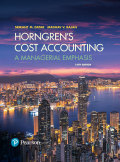
Classification of costs, service sector. Market Focus is a
Required
Classify each cost item (A–H) as follows:
- a. Direct or indirect (D or I) costs of each individual focus group.
- b. Variable or fixed (V or F) costs of how the total costs of Market Focus change as the number of focus groups conducted changes. (If in doubt, select on the basis of whether the total costs will change substantially if there is a large change in the number of groups conducted.)
You will have two answers (D or I; V or F) for each of the following items:
| Cost Item | D or I V or F |
| A. Payment to individuals in each focus group to provide comments on new products | |
| B. Annual subscription of Market Focus to Consumer Reports magazine | |
| C. Phone calls made by Market Focus staff member to confirm individuals will attend a focus group session (Records of individual calls are not kept.) | |
| D. Retainer paid to focus group leader to conduct 18 focus groups per year on new medical products | |
| E. Recruiting cost to hire marketing specialists | |
| F. Lease payment by Market Focus for corporate office | |
| G. Cost of tapes used to record comments made by individuals in a focus group session (These tapes are sent to the company whose products are being tested.) | |
| H. Gasoline costs of Market Focus staff for company-owned vehicles (Staff members submit monthly bills with no mileage breakdowns.) | |
| I. Costs incurred to improve the design of focus groups to make them more effective |
Learn your wayIncludes step-by-step video

Chapter 2 Solutions
EBK HORNGREN'S COST ACCOUNTING
Additional Business Textbook Solutions
Business Essentials (12th Edition) (What's New in Intro to Business)
Intermediate Accounting (2nd Edition)
Corporate Finance (4th Edition) (Pearson Series in Finance) - Standalone book
Engineering Economy (17th Edition)
Financial Accounting: Tools for Business Decision Making, 8th Edition
 Managerial AccountingAccountingISBN:9781337912020Author:Carl Warren, Ph.d. Cma William B. TaylerPublisher:South-Western College Pub
Managerial AccountingAccountingISBN:9781337912020Author:Carl Warren, Ph.d. Cma William B. TaylerPublisher:South-Western College Pub Cornerstones of Cost Management (Cornerstones Ser...AccountingISBN:9781305970663Author:Don R. Hansen, Maryanne M. MowenPublisher:Cengage LearningPrinciples of Accounting Volume 2AccountingISBN:9781947172609Author:OpenStaxPublisher:OpenStax College
Cornerstones of Cost Management (Cornerstones Ser...AccountingISBN:9781305970663Author:Don R. Hansen, Maryanne M. MowenPublisher:Cengage LearningPrinciples of Accounting Volume 2AccountingISBN:9781947172609Author:OpenStaxPublisher:OpenStax College


